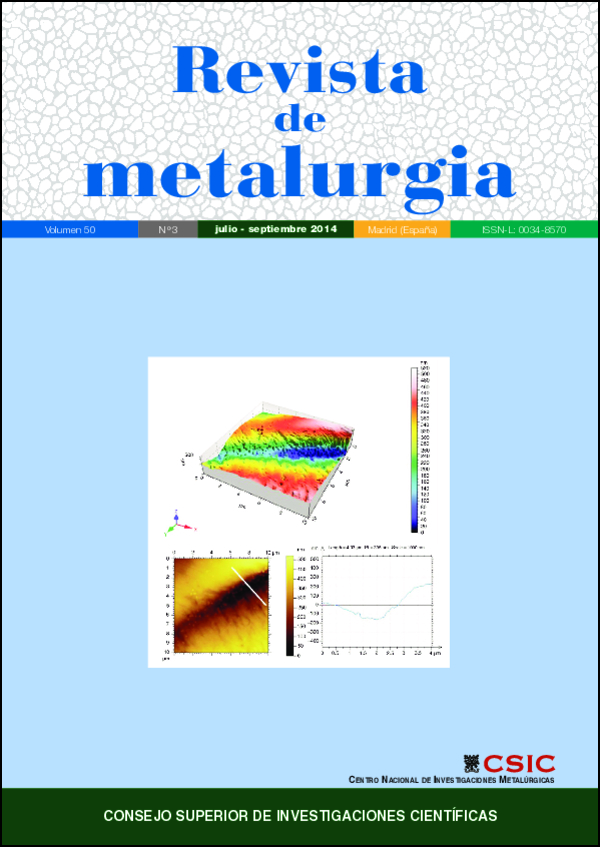Effect of natural aging on the microstructural regions, mechanical properties, corrosion resistance and fracture in welded joints on API5L X52 steel pipeline
DOI:
https://doi.org/10.3989/revmetalm.024Keywords:
API5L X52 steel, Coarsening, Degradation, HAZ, Natural agingAbstract
A characterization study was done to analyze how microstructural regions affect the mechanical properties, corrosion and fractography of the Heat Affected Zone (HAZ), weld bead and base metal for pipe naturally aged for 21 years at 30 °C. Results showed that microstructures exhibited damage and consequently decrease in properties, resulting in over-aged due to service. SEM analysis showed that base metal presented coarse ferrite grain. Tensile test indicated that microstructures showed discontinuous yield. Higher tensile strength was obtained for weld bead, which exhibited a lower impact energy in comparison to that of HAZ and base metal associated with brittle fracture by trans-granular cleavage. The degradation of properties was associated with the coarsening of nano-carbides observed through TEM images analysis, which was confirmed by SEM fractography of tensile and impact fracture surfaces. The weld bead reached the largest void density and highest susceptibility to corrosion in H2S media when compared to those of the HAZ and base metal.
Downloads
References
API 5L (2008). Specification for Line Pipe, 44th Ed., American Petroleum Institute, Washington D.C., USA, pp. 8–17.
ASTM Standard G-102 (2004). Standard Practice for Calculation of Corrosion Rates and Related Information from Electrochemical Measurements. ASTM International, West Conshohocken, PA, USA, pp. 1–5.
ASTM Standard E-112 (2004). Standard Test Methods for Determining Average Grain Size. ASTM, West Conshohocken, PA, USA, pp. 10–12.
ASTM Standard E-384 (2005). Standard Test Method for Microindentacion Hardness of Materials. ASTM, West Conshohocken, PA, USA, pp. 1–8.
ASTM Standard E-23 (2006). Standard Test Methods for Notched Bar Impact Testing of Metallic Materials. ASTM, West Conshohocken, PA, USA, pp. 2–8.
ASTM Standard E-8M (2008). Standard Test Methods for Tension Testing of Metallic Materials. ASTM, West Conshohocken, PA, USA, pp. 7–18.
AWS A5.17 (2004). Specification for Carbon Steel Electrodes and Fluxes for Submerged Arc Welding. American Welding Society, Miami FL, USA, pp. 2–4.
Hamada, I., Yamauchi, K. (2002). Sensitization behavior of type 308 stainless steel weld metals after postweld heat treatment and low temperature aging and its relation to microstructure. Metall. Mater. Trans. A 33 (6), 1743–1754. http://dx.doi.org/10.1007/s11661-002-0183-5
Homma K., Miki C., Yang, H. (1998). Fracture toughness of cold worked and simulated heat affected structural steel. Eng. Fract. Mech. 59 (1), 17–28. http://dx.doi.org/10.1016/S0013-7944(97)00100-8
Jayan, V., Khan, Y.M., Husain, M. (2004). Coarsening of nano sized carbide particles in 2.25Cr–1Mo power plant steel after extended service. Mater. Lett. 58 (21), 2569–2573. http://dx.doi.org/10.1016/j.matlet.2004.02.051
Kotrechko, O.S., Krasowsky, Y.A., Meshkov, Y.Y., Torop, M.V. (2004). Effect of long-term service on the tensile properties and capability of pipeline steel 17GS to resist cleavage fracture. Int. J. Pres. Ves. Pip. 81 (4), 337–344. http://dx.doi.org/10.1016/j.ijpvp.2004.02.015
Krauss, G. (1990). Heat treatment and processing principles. ASM Materials, Park OH, USA, pp. 125–130.
Moon, J., Lee, Ch., Uhm, S., Lee, J. (2006). Coarsening kinetics of TiN particle in a low alloyed steel in weld HAZ: considering critical particle size. Acta Mater. 54 (4), 1053–1061. http://dx.doi.org/10.1016/j.actamat.2005.10.037
NACE ID-182 (1995). Wheel Test Method Used for Evaluation of Film-Persistent Corrosion Inhibitors for Oilfield Applications. NACE, 1440 South Creek Drive, Houston, USA, pp. 1–4.
Saucedo, M.L.M., Komazaki, I.S., Hashida, T., Shoji, T., Lopez, H.V.M. (2003). Aplicación del ensayo miniatura de embutido para la evaluación de la tenacidad a temperaturas criogénicas de aceros inoxidables austeníticos envejecidos isotérmicamente. Rev. Metal. 39 (5), 378–386. http://dx.doi.org/10.3989/revmetalm.2003.v39.i5.350
Vargas, A.B., Albiter, A., Angeles, Ch.C., Hallen, J.M. (2006). Effect of the artificial aging time on the mechanical properties of weldment on API 5L X-52 line pipe steel. Metall. Mater. Trans. A. 37 (9), 2683–2690. http://dx.doi.org/10.1007/BF02586102
Vargas, A.B., Hallen, J. M., Albiter, A. (2007). Effect of the artificial aging on the microstructure of weldment on API 5L X-52 steel pipe. Mater. Charact. 58 (8–9), 721–729. http://dx.doi.org/10.1016/j.matchar.2006.11.004
Vargas, A.B., Hallen, J.M., Albiter, A., Angeles, Ch.C. (2008). Degradation of impact fracture during accelerated aging of weld metal on microalloyed steel. Rev. Metal. 44, 485–492.
Vargas, A.B., Angeles, Ch.C., Albiter, A., Hallen, J.M. (2009). Metallurgical investigation of the aging process on tensile fracture welded joints in pipeline steel. Mater. Charact. 60 (12), 1561–1568. http://dx.doi.org/10.1016/j.matchar.2009.09.007
Vargas, A.B., Solis, R.J., Angeles, Ch.C., Albiter, A., Hallen, J.M. (2011). Deterioration of the corrosion resistance of welded joints in API5L X52 steel isothermally aged. Int. J. Electrochem. Sci. 6 (2), 367–378.
Vargas, A.B., Balvantin, A., Baltazar, A., García, V.F. (2012). On the use of ultrasonic spectral analysis for the characterization of artificially degraded API 5L X52 steel pipeline welded joints. Mat. Sci. Eng. A. 550, 227–234. http://dx.doi.org/10.1016/j.msea.2012.04.064
Watanabe, T., Yamazaki, M., Hongo, H., Tabuchi, M., Tanabe, T. (2004). Effect of stress on microstructural change due to aging at 823 K in multi-layer welded joint of 2.25Cr-1Mo steel. Int. J. Pres. Ves. Pip. 81 (3), 279–284. http://dx.doi.org/10.1016/j.ijpvp.2003.12.017
Published
How to Cite
Issue
Section
License
Copyright (c) 2014 Consejo Superior de Investigaciones Científicas (CSIC)

This work is licensed under a Creative Commons Attribution 4.0 International License.
© CSIC. Manuscripts published in both the printed and online versions of this Journal are the property of Consejo Superior de Investigaciones Científicas, and quoting this source is a requirement for any partial or full reproduction.
All contents of this electronic edition, except where otherwise noted, are distributed under a “Creative Commons Attribution 4.0 International” (CC BY 4.0) License. You may read the basic information and the legal text of the license. The indication of the CC BY 4.0 License must be expressly stated in this way when necessary.
Self-archiving in repositories, personal webpages or similar, of any version other than the published by the Editor, is not allowed.
















